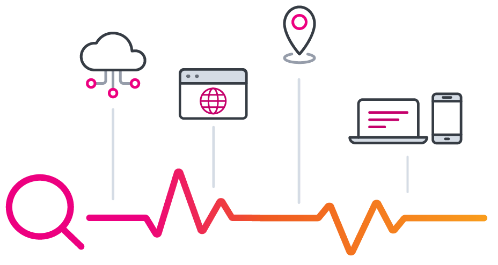Deloitte found that a 0.1 second improvement in mobile site speed resulted in an:
8.4%
increase in retail conversions
9.2%
increase in average order value
The most successful businesses build cultures of web performance

Collaboration has always been a challenge for front-end and back-end development teams. The move to cloud and cloud-native technologies like containers and microservices adds new levels of complexity that make close cooperation both more difficult and more important.
The solution is to create a culture of performance that puts customers first, fosters collaboration and allows development teams to consistently improve performance for better customer experiences.
Synthetic monitoring and web optimization are key ingredients to a culture of performance and collaboration as a competitive edge.
Today, every business is a digital business. And that means that delivering great digital experiences online has to be a top priority.
This puts particular importance on the web development, engineering and IT Ops teams responsible for building, maintaining and improving those customer experiences.
The relationship between web performance and customer conversion is clear.
Deloitte recently looked at mobile site data from retail, travel, luxury and lead generation brands across Europe and the US. Based on a 0.1s natural mobile site speed improvement, Deloitte found that retail conversions increased by 8.4% and average order value increased by 9.2%.
Regardless of industry, web performance matters. Google found that users are 24% less likely to abandon sites that satisfy the standard for core web vitals. Vodafone found that by displaying large images 31% faster, sales increased by 8%. The BBC found that for every second it took for its site to load, the broadcaster would lose 10% of its users.
As consumers continue to turn to digital channels, businesses that invest in building a culture of web performance will realize returns of increased conversion and user activity and decreased abandonment by their users.
There is a direct and measurable relationship between web performance and business outcomes:
To deliver great user experiences, modern development teams rely on advanced synthetic monitoring to help them proactively test, monitor and optimize web performance. By monitoring user endpoints, APIs and business transactions, back-end developers can know instantly when small changes cause big problems.
Synthetic monitoring tests and measures the digital experience of web applications by simulating traffic with set test variables (e.g. network, browser, location, device). Synthetic vendors provide remote (often global) infrastructure that visits a website periodically and records the performance data for each run.
The measured traffic is not of actual users, but rather traffic synthetically generated to collect data on page performance. Behavioral scripts (or paths) are created to simulate a flow that a customer or end user would take on a site. Those paths are then continuously monitored at specified intervals for performance indicators such as functionality, availability and response time.

Optimizing web performance is a journey that puts user and customer experience first.
Simple steps like establishing baselines for user-experience, standardizing on Core Web Vitals, and tracking the performance of new features and improvements, can result in less abandonment, increased usage, and higher revenues.
Take the next step in your performance maturity with a free trial of Splunk Synthetic Monitoring today.
Free Trial
Real user monitoring (RUM) and synthetic monitoring offer different views of web performance. RUM helps teams understand long-term trends, and synthetic monitoring helps diagnose and solve shorter-term performance problems.

CASE STUDY
In order to improve site performance, Blue Apron’s development teams needed a simple way to see what was broken, why it was broken and what should be done to fix it.
With Splunk Synthetic Monitoring, Blue Apron improved site performance by responding to defects quickly and accurately. And with its knowledge base, which includes how-to guides and best practices, Blue Apron elevated performance as a skill set within the team.
From testing new features to identifying easy performance wins, Splunk Synthetic Monitoring helps embed performance across our development life cycle. We’ve decreased load time by 30% with Splunk Synthetic Monitoring, which helps eliminate customer-facing issues and optimize web performance.

Web Optimization:
Synthetic monitoring becomes even more powerful when it’s paired with Splunk Web Optimization, which provides the deepest optimization and performance improvement capabilities of any observability or APM platform.

Like an automated performance consultant, Splunk Web Optimization automatically and proactively guides engineers to more than 300 improvement recommendations. Solutions are automatically prioritized and triaged, and include action items for a quick resolution. Video replay and filmstrips help developers view website experience through the eyes of users.
The commitment to collaboration extends to integrations with Jira, Jenkins, PagerDuty and Slack. When you have a culture of performance, everyone works together to create the best customer experience. Not only do front-end engineers and back-end developers collaborate, but business managers have access to performance data that helps drive decision-making and success in the new world of retail.
Industry’s only solution that auto-updates commercial browsers as new versions are released
Industry’s only solution that automatically identifies and provides instruction for remediating 300+ performance problems
Open source scripting
Out-of-box alert integrations with several systems
Slack, ServiceNow, Splunk On-Call, OpsGenie
48 + UX metrics, including web vitals
Easily push raw data into other BI systems
Waterfall, video and filmstrip of every monitor
Strong CI integrations for shifting left into dev/QA workflow
Splunk Synthetic Monitoring makes sure user experiences are issue-free and integrates seamlessly with Splunk Observability so front-end and back-end development teams can work together to deliver best-in-class web performance.